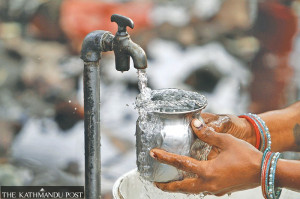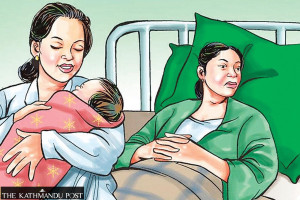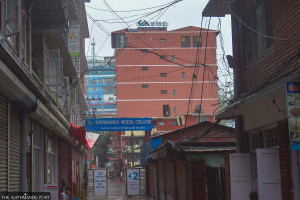Health
Faecal coliform found in all tap water samples from Lalitpur locality
Latest tests in ward 3 of Mahankal Rural Municipality confirm the contamination. A few days ago 60 percent of jar water samples in Godavari was found unsafe.
Arjun Poudel
All water samples collected from household taps in ward 3 of Mahankal Rural Municipality in Lalitpur district have been found contaminated with faecal coliform.
Of the five samples of tap water collected randomly from households, all tested positive for the potentially deadly microbes.
The discovery of faecal coliform in tap water suggests increasing health risk, especially as contamination of drinking water sources is common during the monsoon. But neighbouring Kathmandu is yet to start testing water quality, leaving millions at risk.
“All five samples of water supplied by two drinking water projects have been found contaminated with faecal coliform,” said Shree Bhadra Sharma, an official at the Public Health office in Lalitpur. “We have sent reports and asked the agencies concerned to take measures to prevent outbreaks of water-borne diseases.”
Faecal coliform, a microscopic organism, lives in the intestines of warm-blooded animals or their faeces. The presence of faecal coliform means the water, being used by locals of the municipality, is contaminated with sewage, doctors say.
A few days ago, testing of jar water samples collected from various locations in Godavari Municipality of the district showed that 60 percent were contaminated with the dangerous microbes.
Authorities in the municipality had sealed the factories that were supplying the contaminated water.
Jar water is generally considered safer for drinking compared to the water piped to households. However, the detection of harmful bacteria in jar water samples indicates that the water supplied by most jar companies is not safe for drinking.
Drinking water contamination is not new in the Kathmandu Valley, especially during the monsoon season, when most drinking water sources are contaminated with rainwater. Every year, thousands of people get infected with water-borne diseases—dysentery, typhoid, hepatitis A and E, and cholera.
Health authorities at the district and local levels are expected to regularly test drinking water samples and take appropriate measures to ensure public safety.
Of late many local governments have been carrying out quality checks on drinking water supplied to households, but the Public Health Office, Kathmandu is yet to start such testing.
But officials say preparations are underway.
“We are aware of the risks and are preparing to start quality checks of drinking water supplied to households,” said Basanta Adhikari, chief of the Public Health Office in Kathmandu. “We have health officials serving at the local level to examine water quality and launch awareness campaigns against the risk of infection of water-borne diseases, including cholera.”
When asked why testing was yet to start despite monsoon rains contaminating most drinking water sources, Adhikari said that his office has asked local units to soon start collecting and testing water samples. He said water supply utilities have also been asked to chlorinate the drinking water they supply to households.
Last year, scores of people from several districts, including Kathmandu and Lalitpur, were infected with cholera. Vibrio cholera 01 Ogawa serotype had been confirmed in the stool sample of an infected patient at the time.
Cholera is a highly infectious disease that causes severe diarrhoea and vomiting, which in turn results in dehydration and can lead to death within a few hours if left untreated. The World Health Organisation says cholera is a global threat to public health and an indicator of inequality and a lack of social development.
The monsoon is an epidemic season in Nepal, during which most sources of drinking water are contaminated with dangerous microbes—E coli and faecal coliform—and thousands of people from across the country become infected with water-borne and vector-borne diseases.
Public health experts have urged authorities to launch an awareness drive about the risks and take measures to ensure the supply of safe drinking water to households.




 27.38°C Kathmandu
27.38°C Kathmandu

















